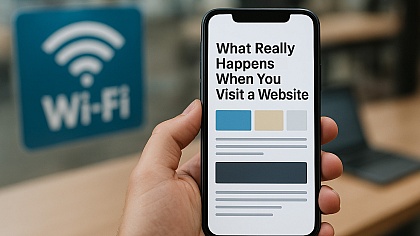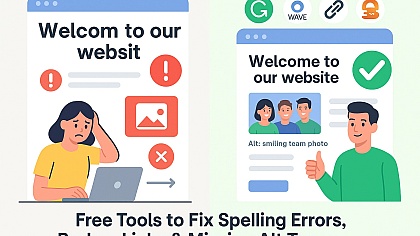
From Idea to Launch: Your 7-Day Plan to Create a Website
In today’s digital age, having a website is essential for anyone looking to make an impact online. Whether you’re a budding entrepreneur or a passionate hobbyist, we all have ideas that deserve to be shared, maybe even with a simple, useful tool that answers common questions like "how do i view my pay stub if i have direct deposit?" to draw in and help your audience. But turning those ideas into a live website can feel overwhelming. That’s where our 7-day plan comes in to simplify the process.
We’ll guide you step-by-step through each day, helping you transform your concept into a fully functional website. From brainstorming and design to launch, we’ll cover everything you need to know to get your site up and running in just a week. With the right approach and a clear roadmap, we can turn your vision into reality, using a clear call to action like "check the store" for a fireworks company to convert visitors into customers.
Overview of the 7-Day Plan
This 7-day plan outlines a structured approach to building a simple website, breaking down the complex process into manageable daily tasks. Each day focuses on vital components that contribute to the successful launch of our site.
|
Day |
Task |
Description |
|
Day 1 |
Idea Generation |
Identify the website's purpose and target audience. |
|
Day 2 |
Content Planning |
Outline essential pages and draft content. |
|
Day 3 |
Design Selection |
Choose a template or framework that suits our needs. |
|
Day 4 |
Development |
Build the website structure and integrate content. |
|
Day 5 |
Testing |
Test website functionality across different devices. |
|
Day 6 |
SEO Optimization |
Implement basic SEO practices for better visibility. |
|
Day 7 |
Launch |
Go live and share our website with the world. |
We start on Day 1 by brainstorming ideas, focusing on clarity and audience engagement. By Day 2, we develop a content plan, ensuring all relevant information appears on our essential pages, such as the home, about, and contact sections.
On Day 3, we identify our design preferences. We can leverage templates that enhance usability and aesthetics. Day 4 emphasizes development where we build out the site, ensuring proper content placement and layout.
Testing on Day 5 is crucial. We check for bugs, broken links, and ensure mobile compatibility. SEO Optimization on Day 6 helps in increasing our website's visibility, allowing potential visitors to find us easily.
Finally, on Day 7, we launch our site, marking the culmination of our efforts. We celebrate this achievement while promoting our website through various channels, ensuring it reaches our intended audience.
Day 1: Ideation and Planning
On Day 1, we focus on establishing the foundation of our website by defining its purpose and identifying our target audience. This clear understanding sets the stage for the rest of our development process.
Defining Your Website Purpose
Defining our website's purpose is crucial. It calls for clarity about what we aim to achieve. We must ask ourselves if we're sharing information, selling products, or promoting services. This goal dictates the design, content, and features needed. For example, an e-commerce site requires product listings and shopping carts, while a blog focuses on articles and images. Taking 30 minutes to write down our primary goals creates a robust guideline that helps streamline every subsequent decision.
Identifying Target Audience
Understanding our target audience shapes the website's design and content. We should consider demographics such as age, gender, interests, and online behavior. Gathering insights through surveys or analytics tools can yield valuable information. For instance, a site targeting millennials may adopt a more visual approach, whereas a professional service may prioritize a clean, minimal design. Creating a persona based on our research helps visualize our audience, ensuring our website addresses their needs effectively and engages them appropriately.
Day 2: Wireframing and Design
Day 2 delves into wireframing and design, two essential steps that bring our website concept to life. We focus on creating a clear visual layout and establishing a sitemap to guide our design process.
Creating a Sitemap
Creating a sitemap provides a structured overview of our website's pages and hierarchy. We outline key sections, such as home, about, services, and contact, ensuring a logical flow. This visual representation helps us identify necessary content and enhances user navigation. Mapping our site facilitates decisions about what links to include, improving the user experience. Tools like Lucidchart or XMind can assist in developing a sitemap, offering flexibility and clarity. By the end of this step, we gain a comprehensive blueprint for our website's organization.
Designing Wireframes
Designing wireframes transforms our sitemap into a visual guide. We sketch layouts for each page, focusing on the placement of text, images, and interactive elements. This stage emphasizes functionality and user interface rather than aesthetics. Tools like Balsamiq or Adobe XD enable us to create low-fidelity wireframes quickly, allowing for easy revisions based on feedback. Each wireframe serves as a draft that outlines how users will interact with our site, ensuring intuitive navigation. By clearly defining these elements, we set the stage for an effective design process that aligns with our website's goals.
Day 3: Content Creation
On Day 3, we focus on content creation, a critical component for engaging our target audience. Effective content serves our website’s purpose while enhancing user experience.
Writing Essential Copy
Writing essential copy demands clarity and conciseness. We start by drafting headlines that capture attention and clearly convey our message. Each section should deliver value, answering common questions our audience may have. We also use bullet points or numbered lists to enhance readability and highlight key information. Ensuring our tone aligns with our brand fosters trust with our readers. Incorporating relevant keywords throughout the content boosts search engine optimization (SEO), helping us reach our audience effectively. Tools like Grammarly or Hemingway Editor can assist in refining our text for grammatical precision and visual appeal.
Sourcing Images and Media
Sourcing images and media enhances our website's visual appeal. We should seek high-quality images that resonate with our content and audience. Stock photo websites like Unsplash or Pexels offer free, professional images that can elevate our site's aesthetics. Additionally, creating custom graphics using Canva can add a personal touch. We must ensure all media is properly attributed and licensed for use to avoid copyright issues. Videos can also enrich the user experience; platforms like YouTube or Vimeo provide easy embedding options. Overall, a thoughtful selection of images and media will create a more engaging and dynamic website.
Day 4: Development Setup

Day 4 focuses on our development setup, where we build the website structure and integrate the content created in previous days. To ensure a smooth process, we will choose the right tools and set up our hosting and domain.
Choosing the Right Tools
Selecting appropriate tools is crucial for our website's development. We can use popular content management systems (CMS) like WordPress or static site generators like Jekyll. Both options provide flexibility and ease of use. Additionally, opting for code editors such as Visual Studio Code or Sublime Text enhances our coding experience. These editors offer features like syntax highlighting and plugins that streamline our workflow. If we prefer a more visual approach, platforms like Squarespace allow drag-and-drop functionality, simplifying the development process without coding knowledge.
Setting Up Hosting and Domain
Establishing our hosting and domain forms the backbone of our website. First, we should choose a reliable hosting provider like Bluehost, SiteGround, or DigitalOcean, which offer various plans based on our needs. After selecting the hosting provider, we can register our domain name through their service or a dedicated registrar like Namecheap or GoDaddy. A domain name should reflect our brand and be easy to remember. Once we complete these steps, we link the domain to our hosting server, setting the stage for web traffic and user engagement.
Day 5: Building the Website
Building the website combines developing the frontend and implementing backend functionality. We focus on creating a cohesive, user-friendly experience while ensuring smooth operations behind the scenes.
Developing the Frontend
Developing the frontend involves crafting the visual elements users interact with. We utilize HTML, CSS, and JavaScript to create responsive layouts that adapt to different devices. Frameworks such as Bootstrap or Tailwind CSS can accelerate development, providing pre-designed components that enhance usability. Ensuring accessibility standards, such as proper alt text for images, guarantees our website is inclusive. Tools like Chrome DevTools assist in testing responsiveness. By optimizing load times through image compression and minifying CSS and JavaScript files, we improve overall performance, enhancing user satisfaction.
Implementing Backend Functionality
Implementing backend functionality focuses on the server-side operations, ensuring data processing and storage run efficiently. We choose a suitable programming language, like PHP, Python, or Node.js, based on project requirements. Integrating a database, such as MySQL or MongoDB, allows us to store and retrieve information effectively. We build RESTful APIs to facilitate communication between the frontend and backend. Additionally, implementing security measures, like HTTPS and proper authentication protocols, protects user data. Testing with tools like Postman verifies that our APIs function correctly, ensuring a smooth user experience later on.
Day 6: Testing and Optimization
Testing and optimization ensure our website operates smoothly and efficiently. We focus on usability and performance to enhance the overall user experience.
Conducting Usability Tests
Usability tests assess how easily users navigate our website. We select a diverse group of testers representing our target audience. Observing them as they complete tasks helps identify pain points. Tools like UserTesting or Lookback can facilitate remote sessions. Collecting feedback on navigation, layout, and content highlights areas needing improvement. Iterative testing allows us to refine our design, ensuring that users find the experience intuitive and enjoyable. Making small changes based on tester insights leads to a more user-friendly site.
Optimizing for Performance
Performance optimization enhances load speed and overall responsiveness. We start by analyzing our site with tools like Google PageSpeed Insights or GTmetrix. These tools provide detailed reports highlighting areas for improvement. Implementing strategies like compressing images, minimizing CSS and JavaScript files, and leveraging browser caching contributes to faster load times. We also aim for mobile responsiveness, ensuring our site performs well across devices. Regular performance checks help maintain speed and efficiency, creating a smoother experience for our visitors.
Day 7: Launch Day
We reach the exciting culmination of our 7-day plan: launch day. This day brings the opportunity to unveil our hard work and share our website with the world.
Final Checklist Before Launch
We conduct a thorough final checklist to ensure everything is in place. We verify that all links function correctly and that the content displays properly across devices. We confirm that the website loads quickly, aiming for under 3 seconds, and that SEO fundamentals are in place, including meta tags and alt text for images. We review our social media connections to amplify reach and assess analytics tools like Google Analytics to track performance post-launch. Ensuring security measures like SSL certificates are active protects our site and users.
Promoting Your New Website
We take proactive steps to promote our new website. We begin by leveraging our social media networks to announce the launch, incorporating engaging visuals and calls to action. We engage with relevant online communities and forums, sharing our website where appropriate. Email marketing campaigns target our existing contacts to inform them about the launch and encourage visits. We consider running targeted online ads, utilizing platforms like Google Ads and Facebook Ads, to broaden our reach. Establishing connections with influencers can further enhance exposure and drive traffic to our site. For more insights on web development, check out W3Schools.














